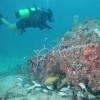 Coral reefs are one of southeast Florida’s most highly valued ocean resources. Despite their economic and ecological importance, they continue to face damage and destruction from human activity. “Artificial reefs” can help restore damaged coral reefs or mitigate their loss. Hundreds these natural and man-made structures have been deployed in southeast Florida coastal waters over the last 30 years. However, construction practices, design features and use patterns associated with this reef-building all have the potential to affect coral ecosystems. This 162-page guide describes artificial reef science and technology as a means of helping practitioners with varied backgrounds, skills and experience achieve responsible and sustainable reef development. Written by William Lindberg and William Seaman, and published by the UF Florida Sea Grant Program, June 2012.
Coral reefs are one of southeast Florida’s most highly valued ocean resources. Despite their economic and ecological importance, they continue to face damage and destruction from human activity. “Artificial reefs” can help restore damaged coral reefs or mitigate their loss. Hundreds these natural and man-made structures have been deployed in southeast Florida coastal waters over the last 30 years. However, construction practices, design features and use patterns associated with this reef-building all have the potential to affect coral ecosystems. This 162-page guide describes artificial reef science and technology as a means of helping practitioners with varied backgrounds, skills and experience achieve responsible and sustainable reef development. Written by William Lindberg and William Seaman, and published by the UF Florida Sea Grant Program, June 2012.
http://edis.ifas.ufl.edu/sg101
Tag: Bill Lindberg
SGEB65/SG100 Understanding the Ecology of Artificial Reefs: No Simple Answers
SGEB65, a 4-page illustrated article by Bill Lindberg and Mark Schrope, discusses the ecological impacts of artificial reefs and implications for conservation in interview format. Published by the UF Florida Sea Grant Program, March 2010.
http://edis.ifas.ufl.edu/sg100